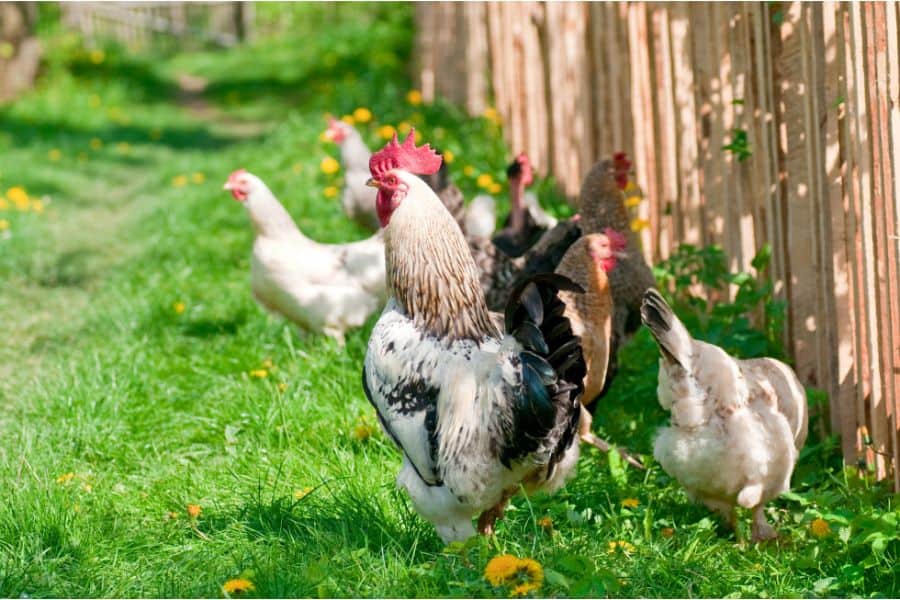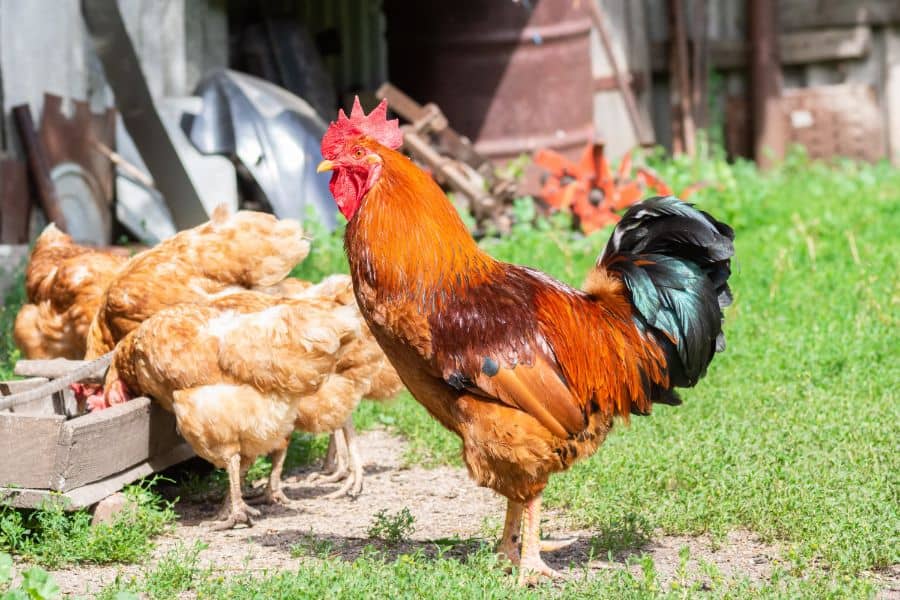Are you new to raising chickens? Do you want to know how many hens you should have for your rooster?
Maintaining balance in your flock is the key to preventing unnecessary fights and improving your birds’ health.
If you raise too many roosters, they will wreak havoc in the coop and stress out your girls. When the cockerels are fewer, you risk getting infertile eggs as the hens might not get a chance to mate.

But what is the right rooster-to-hen ratio?
Well, we are here to answer this question and more. This post explores the ideal ratio of hens to roosters and offers you a few tips to maintain peace within your flock.
What Is the Ideal Rooster to Hen Ratio?
Whether you have a few backyard chickens or raising them on a larger scale, it’s crucial to create harmony between the hens and roosters. By doing so, you can foster productivity and sustainability.
But this only works if you know how many hens you should have for each rooster within the flock.
Experts recommended 3 to 10 hens for one rooster. However, this ratio can change based on some factors, including:
1. Availability of Space
The more roosters you have, the more space you need. Male chickens don’t like being raised in a cramped coop. They can become more aggressive and territorial, leading to chaos.
If you have 10 to 15 hens, a single rooster will have sufficient space to roam around. But if you introduce another rooster, consider expanding the available room.
2. Breed and Temperament
If you have an aggressive rooster breed, like Rhode Island Red, maintain a lower rooster-hen-ratio. This way, you can prevent bullying and the pecking of other flock members.
Submissive or docile breeds, like Wyandottes, can handle a higher ratio. You can have 10 to 15 hens for a single rooster.
Observe the rooster’s temperament too. If it’s too aggressive towards the females, we recommend you reduce the ratio.
3. Pecking Order
Do you have a single male chicken in your flock? Chances are, he’s the top chook in the pecking order.
Roosters often display confidence and loyalty and protect their ladies from danger. They also offer guidance to the chicks and prevent squabbles.
However, if you have multiple roosters, they might constantly battle to determine who’s fit to become the alpha of the flock. The fights can cause stress for the entire flock, resulting in poor health and reduced egg production.
To maintain a stable pecking order, keep at least 6 to 10 hens per rooster. Observe how the ladies interact with the guy. If there are signs of aggression and bullying, adjust the ratio to protect the hens.
What to Consider When Determining the Optimal Ratio for Your Coop?

Age and Experience of Rooster
Older or more mature roosters can handle a higher hen-to-rooster ratio. But if you have a young rooster, start with a few hens. Adjust the number of girls as he matures.
Breeds of Chickens
As said above, the chicken breeds you keep can help you determine the appropriate ratio. Oftentimes, smaller breeds do better with a lower ratio. If you have large breeds, you’ll want to have more hens per rooster (8:1).
Here’s a summary of the approximate hens-to-rooster ratio for common chicken breeds:
| Chicken Breed | Hens-to- Rooster Ratio |
| Rhode Island Red | 10-12 hens per rooster |
| Silkie | 4 – 6 hens per rooster |
| Wyandotte | 8 – 10 hens per rooster |
| Orpington | 6 – 8 hens per rooster |
| Leghorn | 10 – 12 hens per rooster |
| Plymouth Rock (Barred Rock) | 8 – 10 hens per rooster |
Purpose of Your Flock
Why are you keeping chickens? Is it for egg production or breeding purposes? If it’s for egg laying, keep at least 7 to 10 hens for one rooster. A lower ratio of 3 to 6 hens per rooster works well for breeding flocks.
Recommended Number of Hens Per Rooster
Although the specific hens-to-rooster ratio depends on many factors, experts recommend raising 2 to 5 hens per rooster.
This ratio reduces competition for dominance and fights among roosters. At the same time, it ensures all the hens are inseminated.
The minimum number of hens per rooster is 2 hens. But still, the rooster might get overly aggressive during mating because he has only ladies to chase, which can lead to stress. To avoid this, introduce one more hen to make three hens per rooster.
The best ratio is 4 to 5 hens to one rooster. It ensures the rooster’s attention and mating needs are distributed evenly. That means the hens will have more time to roam freely, forage, and lay eggs in peace.
How Many Hens Can a Rooster Service?
You need one rooster for every 10 to 12 hens. This ensures all the hens get serviced and their eggs fertilized. If you increase the number of hens, your rooster might struggle to service them.
Your rooster might fail to service your girls or fertilize their eggs if he is past his prime time. In such a situation, swap the male chicken with a younger, more energetic cockerel.
Certain chicken breeds like the Cohins have fluffy, which makes it difficult for the rooster to service the ladies. The solution to this is to trim the excess butt feathers to help the rooster find his way.
How Many Roosters for 15 Hens?
Some poultry farmers say one rooster is enough to service 15 hens. While that’s true, the rooster might not be able to give each hen the attention it deserves. As such, you might have cases of unfertilized eggs.
The best course of action in this situation is to introduce another rooster. But increase the available space to prevent dominance or territorial fights.
If you live in urban areas, consider the noise levels and your neighbor’s tolerance to crowing before adding another rooster.
Signs Your Flocks Need More Roosters
The following factors work as quick signals that your flock needs more roosters.
1. Stressed Hens
When too many hens vie for the attention of one rooster, they can easily get stressed. Your girls want a male chicken that can protect them from predators and mate with them regularly.
But if there are fewer roosters, the hens can fight among themselves and experience anxiety.
Besides, they might exhibit several physical and behavioral changes, including:
- Abnormal feathering
- Constant feather preening, even without external parasites
- Heightened aggression like cannibalism and feather-pecking
- Relentless and aimless pacing of birds housed on the floor
2. Reduced Egg Production
An unhappy hen translates to a drop in egg production. An unbalanced flock means fewer males to service the hens and fertilize eggs.
You can solve this problem by adding a young cockerel to the mix to create balance. Your hens will also feel at ease with roosters around, which encourages them to lay eggs.
3. Aggressive Roosters
Aggression and cannibalism are among the significant causes of stress and death in poultry. If left unguarded, hens can fight, chase, and peck at each other, which disrupts the flock dynamics.
To diffuse the aggression, bring more roosters to the flock. With more roosters, your hens will not compete as fiercely. More roosters also mean more protection for your hens.
How to Introduce New Roosters to Your Flock
Implement these steps to introduce new roosters to your flock successfully.
- Keep the new rooster secluded from the hens for a few days – You can use a wire mesh to facilitate indirect contact before flocking them together.
- Watch over the first physical contact of your roosters with your hens – You can release them in a fenced space in your yard and supervise their behavior.
- Make several nesting spots. Ensure the coop is large enough to allow chasing, pecking, and chest-bumping as your rooster dominates the flock.
- Supervise mating conduct – Ensure your hens have access to various nesting spots to hide from the rooster when the need arises.
Closing Words
To keep your flock healthy, it’s important to maintain the right hen-to-rooster ratio, regardless of your experience level.
Based on our research, we’ve determined 10 chickens to 1 rooster as the most ideal ratio, as it fosters harmony among your birds. But remember, factors like chicken breeds, available space, age of the rooster, and pecking order could affect this ratio.
For the best results, we suggest you observe your flock regularly and make necessary adjustments to meet their needs.
Give the right conditions and care, and your chatty friend will enjoy peace. And they will say thank you for providing you delicious fresh eggs for many years.
